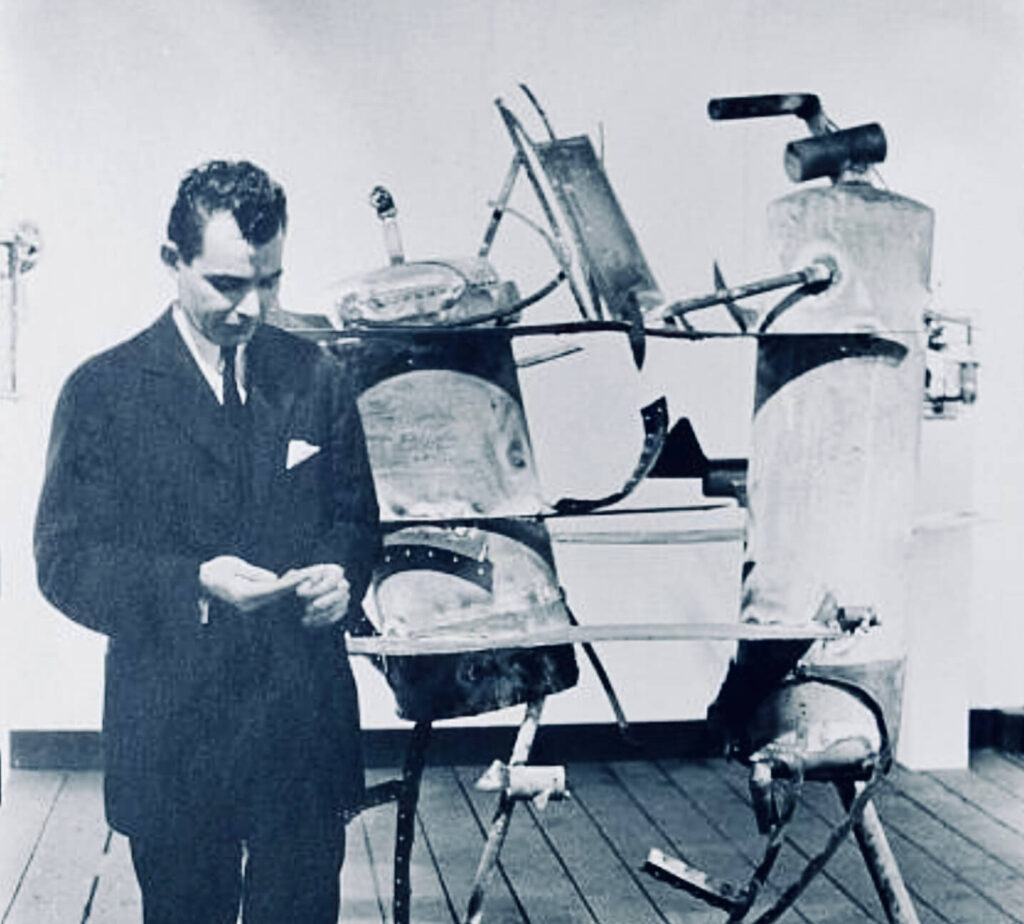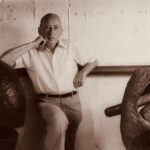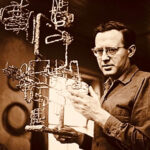Richard Stankiewicz
Richard Stankiewicz (1922-1983) was an influential American sculptor renowned for his innovative use of scrap metal and found objects to create expressive and often whimsical works of art. Stankiewicz’s ability to transform discarded materials into poignant and dynamic sculptures established him as a pioneering figure in the field of assemblage art. His work challenges traditional notions of sculpture and celebrates the beauty of everyday objects, reimagined through his creative vision.

Early Life and Education
Richard Stankiewicz was born on October 18, 1922, in Philadelphia, Pennsylvania. He grew up during the Great Depression, a period that significantly shaped his outlook on art and life. The resourcefulness necessitated by the economic hardships of the time would later influence his choice of materials and his approach to sculpture.
Stankiewicz’s early interest in art was nurtured by his mother, who encouraged his creative pursuits. After graduating from high school, he enrolled at the Vesper George School of Art in Boston, where he studied commercial art. However, his true passion lay in fine art, and he soon moved to New York City to study at the prestigious Art Students League.
At the Art Students League, Stankiewicz studied under several prominent artists, including George Grosz and Hans Hofmann. Hofmann’s teachings on abstraction and the dynamics of form and space had a profound impact on Stankiewicz’s development as an artist. During this period, Stankiewicz also became acquainted with the burgeoning Abstract Expressionist movement, which further influenced his evolving artistic style.
Military Service and Post-War Transition
During World War II, Stankiewicz served in the U.S. Navy, where he worked as a photographer and cartographer. His military service took him to various parts of the world, exposing him to diverse cultures and artistic traditions. After the war, Stankiewicz returned to New York City and continued his studies at the Art Students League. He also began to explore new artistic directions, moving away from traditional painting and drawing toward sculpture.
The post-war years were a time of great experimentation and innovation in the art world, and Stankiewicz was keenly aware of the new possibilities opening up for artists. He became involved with the Club, an influential group of artists and intellectuals who met regularly to discuss contemporary art and ideas. Through the Club, Stankiewicz formed connections with other leading artists of the time, including Willem de Kooning, Franz Kline, and David Smith.
Discovery of Assemblage and Scrap Metal Sculpture
In the early 1950s, Stankiewicz began experimenting with assemblage, a technique that involves creating art from found objects and everyday materials. Inspired by the Dadaist and Surrealist traditions, as well as the work of artists like Kurt Schwitters and Marcel Duchamp, Stankiewicz saw the potential to create meaningful and expressive works from discarded items.
Stankiewicz’s first major breakthrough came when he started using scrap metal as his primary material. He scoured junkyards and salvage yards for old machinery parts, tools, and other metal objects, which he then welded and bolted together to form sculptures. This approach allowed him to create works that were both abstract and representational, imbued with a sense of playfulness and irony.
His early scrap metal sculptures, such as “Bull” (1954) and “Odalisque” (1956), showcased his ability to transform industrial detritus into dynamic and expressive forms. These works were characterized by their rough textures, bold shapes, and inventive use of materials. Stankiewicz’s sculptures often retained the original character of the found objects, while simultaneously reconfiguring them into new, unexpected compositions.
Important Artwork: “The Lion” (1960)
One of Richard Stankiewicz’s most significant works is “The Lion” (1960), a sculpture that exemplifies his mature style and his mastery of assemblage techniques.
“The Lion” (1960)
“The Lion” is a large-scale sculpture made from an assortment of welded metal objects, including gears, pipes, and sheet metal. The work stands approximately six feet tall and captures the essence of its titular subject with a combination of abstraction and representation.
The composition of “The Lion” is both imposing and playful, with its intricate arrangement of metal parts evoking the strength and majesty of the animal. The sculpture’s rough, textured surfaces and jagged edges convey a sense of raw power, while the careful placement of each component reveals Stankiewicz’s keen eye for balance and harmony.
At the heart of the sculpture is a central form that suggests the lion’s head and mane. Stankiewicz used a variety of metal pieces to create a complex, layered effect, with overlapping shapes and protruding elements that give the impression of a wild, untamed mane. The use of gears and other mechanical parts adds a sense of movement and vitality, as if the lion is poised to spring into action.
“The Lion” is notable for its ability to evoke the spirit of the animal without relying on realistic depiction. Instead, Stankiewicz used the inherent qualities of the found objects to suggest the lion’s form and character. This approach allows the viewer to engage with the sculpture on multiple levels, appreciating both the ingenuity of its construction and the symbolic resonance of its imagery.
The creation of “The Lion” also reflects Stankiewicz’s broader philosophical concerns. By transforming industrial waste into a powerful and evocative artwork, he challenged conventional notions of beauty and value. The sculpture embodies his belief in the potential for renewal and transformation, both in art and in life.
Later Career and Recognition
Throughout the 1960s and 1970s, Stankiewicz continued to explore the possibilities of assemblage and scrap metal sculpture. His works became increasingly complex and ambitious, often incorporating larger and more varied materials. He also began to experiment with other media, including wood and stone, although metal remained his primary focus.
Stankiewicz’s contributions to modern sculpture were increasingly recognized during his lifetime. He received numerous awards and honors, including a Guggenheim Fellowship in 1962 and a retrospective exhibition at the Whitney Museum of American Art in 1969. His works were included in major exhibitions at museums and galleries around the world, and he participated in important group shows such as the Venice Biennale.
In addition to his artistic achievements, Stankiewicz was also a dedicated teacher and mentor. He taught at several institutions, including the University of New Mexico and the State University of New York at Albany, where he influenced a new generation of sculptors and artists. His commitment to education and his willingness to share his knowledge and experience made him a respected figure in the art community.
Legacy and Influence
Richard Stankiewicz’s legacy as a sculptor lies in his ability to transform ordinary materials into extraordinary works of art. His innovative use of scrap metal and found objects helped to redefine the possibilities of sculpture, challenging traditional boundaries and opening up new avenues for artistic expression.
Stankiewicz’s influence can be seen in the works of subsequent generations of artists who have been inspired by his inventive approach and his emphasis on materiality. His sculptures, with their combination of abstraction and representation, continue to resonate with viewers and artists alike, reminding us of the potential for creativity and transformation in the everyday world.
Personal Life and Philosophy
Stankiewicz’s personal life was marked by his dedication to his art and his passion for exploring the possibilities of form and material. He maintained a close-knit circle of friends and collaborators, including fellow artists and writers who shared his interest in pushing the boundaries of artistic practice.
Stankiewicz’s artistic philosophy was rooted in a belief in the power of art to reveal new perspectives and meanings. He viewed his sculptures as a way to engage with the world and to uncover the hidden beauty and potential of discarded objects. This approach is evident in the vitality and dynamism of his works, which continue to captivate and inspire viewers.
Despite facing periods of financial difficulty and critical indifference, Stankiewicz remained committed to his artistic vision. His perseverance and dedication to his craft are reflected in the body of work he created, which stands as a testament to his talent and his belief in the importance of art.
Conclusion
Richard Stankiewicz’s artistic journey is a testament to his creativity, resilience, and profound understanding of form and material. Through his innovative approach to assemblage and scrap metal sculpture, he created a body of work that continues to inspire and challenge viewers. “The Lion,” one of his most important works, exemplifies his ability to convey complex ideas and emotions through abstract means.
In celebrating Richard Stankiewicz’s life and work, we recognize his significant contributions to the development of modern sculpture and his enduring legacy as an artist who saw potential and beauty in the overlooked and discarded. His sculptures remain powerful and evocative, reminding us of the transformative potential of art and the importance of seeing the world through new eyes. Stankiewicz’s exploration of form and material continues to resonate, inviting us to contemplate the hidden possibilities that lie within the everyday objects around us.



